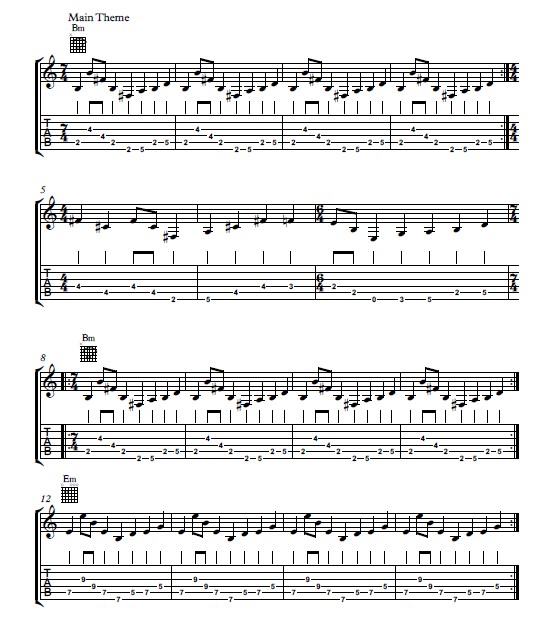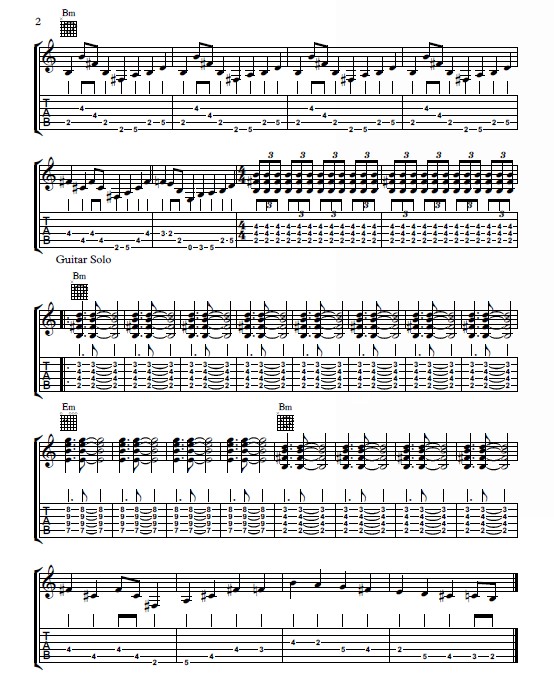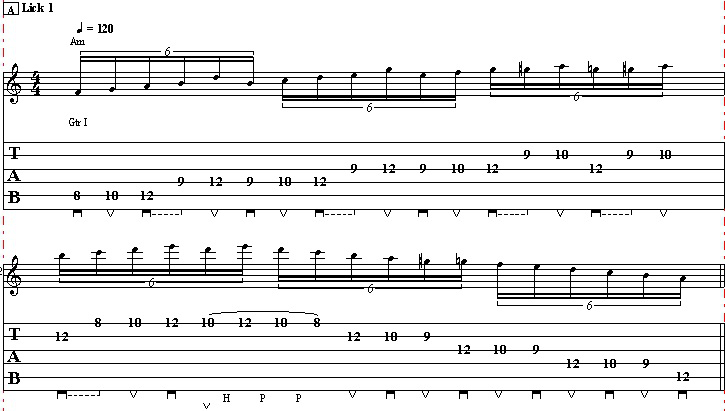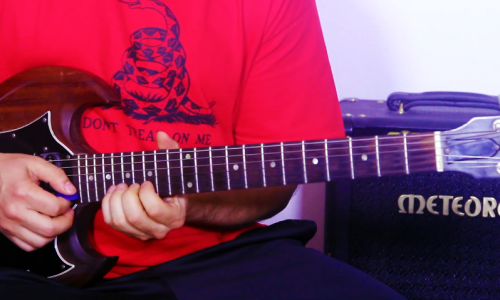

Hey, how’s it going this is Jon McLennan with Guitar Control, hope you’re doing fantastic I’m here bringing you this video lesson on a song called “Money” by Pink Floyd. This is a Classic tune, I’m going to break it down for you step by step, we’re going to learn that main riff, then we’re going to get the sax solo, and some rhythm parts you can do for the guitar solo.
We’re going to take it all the way out, it’s a long song, and one of the interesting things about it, is it’s in the seven four, so you have seven beats per measure one, two, three, four, five, six, seven, one, and it has a few meter changes as well.
Check the image above to follow the chords and tabs.
The main theme is based off a b minor chord; let me play it for you first. What I’m doing to play this riff is kind of envisioning a b power cord, which would be two, four, four, and I’ve got my first finger on that fifth string, second fret third pinky, and then palm muting over with the right hand, and laying this part of my palm down at the string where the string meets that saddle piece.
I’m getting this sound instead, so I start playing the fifth string then go up to the third string, come back and work my way back. That’s one, two, and three, then bring my first finger up to the second fret sixth string, pinky fifth fret, and do the same one string down two, five, so it’s two, five, two, five, so I’ve got a power chord shape and finishing it up with two, five, two, and five.
Let’s try it slow; you can see that the fifth fret, when I go to five to five, on both fives. I just give a little pull on the string for some personality kind of blues. It’s the flat third and the flat seventh of the chord, that’s the main theme and one of the most interesting things about this is actually in seven, four, so I’m going one, two, and three, four, five, six, seven, one, two, and three, four, five, six, seven, one, not a lot of pop songs.
I can’t think of any pop songs that are in seven, I think rush had experimented with odd meter as well, but it’s one of those riffs where you’ve heard it many times, you can pick up the count on it without even knowing that you’re playing in seven, one, two, and three, four, five, six, seven, one, two, and three, four, five, six, seven, one, and then the next section goes like this.
That’s the new caviar and what I’ve basically done is similar thing moving up one string and I’m going to play the fourth fret on the fourth string, four, and then four on the fifth string, then come up with your pinky five, four, four, three, two, two, zero, three, zero, two, five same thing a little pull on that note back to the main theme one more time here then we go to the new caviar. Now, what’s happening here is we’re playing two bars of four and one bar of six so it’s one, two, three, and four, one, two, three, four, one, and two, three, four, five, six, one, two, three, four, five, six, seven, one, two, three, four, the meter’s actually all over the place it’s really hip though the main theme is broken down for you.
Next up we head into the sax solo, let’s check it out the next section goes into a saxophone solo, and you can continue that main theme riff for most of the saxophone song. We’re going to move it around, so I’ll show you how we start out with that riff. I just played it four times, then we do it eight times, we’ll do that real quick third time, fourth time, fifth time, six times, seven, and last eight time, then you go up two. What I’m doing there is took that same riff and relocated it up a fourth which would be five frets, so I slide this shape up to the seventh fret starting on the note e, now I’m going to do the same riff seven, nine, nine, seven, seven, ten, seven, ten, and again. This time half the length four times then you go back to the first part and repeats again, and tag it with this part, then we go into the guitar solo. So what I did basically is just a bunch of triplets out of that that part, right here b power chord, and then we go into the guitar solo.
I’m going to show you a basic rhythm pattern that you can play behind the multiple solos so out of those triplets you go into a rhythm part that can be played like this, I’m basically playing a standard comping rhythm, behind the lead guitar solo and this follows a basic sort of 12 bar blues structure and the first chord shape was b minor going two, four, four, three, and the rhythm that I was doing was just one, and two, and three, four, so I kind of play on one, and then two, one, and two, three.
That would go for eight bars and then move that same grip up to the seventh fret and you’ve got an e minor this would be seven, nine, nine, eight, and then I tag it with the riff from earlier until that note. And then we do this descending walk down lick that’s the fourth fret on the third string second fret coming up one string to the fourth string fifth fret, fourth fret second fret and they’re all quarter notes one, two, three, four, by the way at this point we have switched to four beats per measure so one, two, three, four, and then the next measure goes second fret, fifth fret, fourth fret, three, and two.
On that note put the chord with the last four bars and it looks like this. Let’s play that whole guitar solo and the comping for it, and we’ll take it out we go one, two, three, four to e minor, back to the minor and that repeats multiple times for all the solos, and then you come out of that last time, you go back to the main theme and play it all the way out.
I hope that helps you get started with this song and for more information don’t forget to subscribe on our You Tube Channel and we’ll see you in our next video, thanks for watching.



